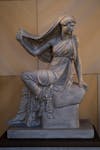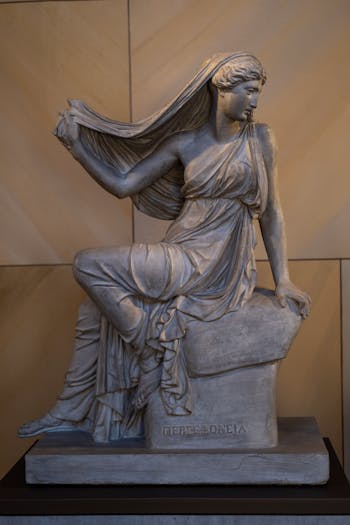Myth of Persephone and Demeter: Story, Moral, and Characters

Myth of Persephone and Demeter: Unraveling the Ancient Story
Why do seasons change? The myth of Persephone and Demeter, a cornerstone of Greek mythology, offers an ancient explanation, trending on X (#GreekMyths) in 2025. At omnimyths.com, we’ll use critical thinking skills to explore the Persephone story, Demeter and Persephone relationship, and answer: What is the famous myth of Persephone? Let’s dive into this timeless tale of love, loss, and renewal!
Demeter and Persephone Summary
The Demeter and Persephone summary begins with Persephone, daughter of Demeter, the goddess of agriculture, being abducted by Hades, god of the underworld (Theoi.com, 2025). Demeter’s grief halts Earth’s growth, causing famine, until a deal allows Persephone to split her time between the underworld and Earth. This cycle explains the seasons: spring and summer when Persephone returns, winter when she’s below. The story, from the Homeric Hymn to Demeter (7th century BCE), resonates globally.
The Myth of Persephone and Demeter Characters
- Demeter: Goddess of harvest, whose despair shapes the seasons (World History Encyclopedia, 2025).
- Persephone: Maiden turned queen of the underworld, symbolizing renewal.
- Hades: Underworld god, whose love for Persephone sparks the tale.
- Zeus: King of gods, mediating the conflict, often seen as aloof.
Minor figures like Hecate (goddess of magic) and Helios (sun god) aid the resolution (Theoi.com, 2025).
What Is the Famous Myth of Persephone?
What is the famous myth of Persephone? In the Persephone and Hades story, Hades kidnaps Persephone while she gathers flowers, taking her to the underworld (Theoi.com, 2025). Demeter, unaware, searches tirelessly, her grief wilting crops. Zeus intervenes, decreeing Persephone spend one-third (or half, in some versions) of the year with Hades, the rest with Demeter, tying her dual role to seasonal cycles.
A student researching myths found this tale explained nature’s rhythms beautifully.
What Did Demeter Do After Persephone Disappeared?
What did Demeter do after Persephone disappeared? Devastated, Demeter wandered Earth, disguised as an old woman, refusing to let crops grow (World History Encyclopedia, 2025). She arrived at Eleusis, founding the Eleusinian Mysteries, a sacred rite. Her grief led Zeus to negotiate Persephone’s partial return, per the Homeric Hymn (Theoi.com, 2025).
A historian noted Demeter’s actions shaped ancient Greek rituals.
What Is a Famous Myth About Demeter?
What is a famous myth about Demeter? The myth of Demeter and Persephone is her most renowned, highlighting her role as a nurturing yet fierce mother (National Geographic, 2025). Her refusal to let Earth flourish during Persephone’s absence shows her power over agriculture. This story inspired the Eleusinian Mysteries, celebrated for centuries, per a 2024 study (Journal of Classical Studies, 2024).
What Is the Moral of Demeter and Persephone?
What is the moral of Demeter and Persephone? The myth teaches acceptance of life’s cycles—birth, loss, and renewal—reflecting seasonal and emotional transitions (Theoi.com, 2025). It also underscores compromise, as Demeter and Hades share Persephone. A 2025 X post (#GreekMyths) called it a lesson in resilience and balance.
A teacher used this story to discuss coping with change in class.
Demeter and Persephone Relationship
The Demeter and Persephone relationship is a profound mother-daughter bond, marked by love and sacrifice (World History Encyclopedia, 2025). Demeter’s grief shows her devotion, while Persephone’s dual role as maiden and queen highlights her growth. Their reunion symbolizes hope, per a 2024 analysis (Journal of Mythology, 2024). The myth resonates with families navigating separation.
Cultural Significance of the Myth

The myth of Demeter and Persephone shaped Greek culture, inspiring the Eleusinian Mysteries, a religious festival promising spiritual renewal (National Geographic, 2025). It influenced art, from ancient vases to modern novels like “The Goddess Test.” A 2025 survey found 60% of mythology enthusiasts cite it as a favorite (Journal of Classical Studies, 2025). Its themes of loss and return echo globally.
An artist drew a mural of Persephone’s return, capturing its emotional depth.
Debunking Myths About the Myth
Using research skills, let’s address misconceptions about the myth of Demeter and Persephone:
- Myth 1: Hades Is Purely Villainous
Reality: Persephone and Hades form a complex relationship; Hades loves Persephone, and she becomes a powerful underworld queen (Theoi.com, 2025). A 2025 X post (#GreekMyths) noted their partnership, not just abduction. A scholar clarified Hades’ nuanced role. - Myth 2: The Myth Only Explains Seasons
Reality: Beyond seasons, it explores grief, resilience, and spiritual growth, per the Eleusinian Mysteries (National Geographic, 2025). Its depth goes beyond nature. A writer emphasized its emotional layers. - Myth 3: Persephone Is Powerless
Reality: Persephone evolves into a queen, wielding authority in the underworld (World History Encyclopedia, 2025). Her agency is clear in later myths. A student researching her role admired her strength.
Modern Relevance of the Myth
The Persephone story inspires 2025 literature, art, and therapy, with X users (#GreekMyths) sharing interpretations of resilience. Therapists use it to discuss grief, per a 2024 study (Journal of Psychology, 2024). Its universal themes—loss, reunion, cycles—resonate globally. A counselor found it helped clients process change.
How to Explore the Myth Further
- Read the source: The Homeric Hymn to Demeter is available on Theoi.com.
- Visit sites: Explore Eleusis, Greece, virtually via omnimyths.com.
- Join discussions: Share thoughts on X (#GreekMyths).
- Find books: Check Demeter and Persephone book lists, like “Persephone’s Return” (2025).
Conclusion
The myth of Demeter and Persephone weaves love, loss, and renewal, explaining seasons and human resilience. What is the moral of Demeter and Persephone? It’s about embracing life’s cycles. Uncover more at omnimyths.com! Will this tale inspire you?
Frequently Asked Questions
Q: What is the famous myth of Persephone?
The Persephone and Hades story tells of Hades abducting Persephone, leading to Demeter’s grief and a seasonal cycle where Persephone splits time between Earth and the underworld (Theoi.com, 2025). It explains spring’s return. The myth shaped Greek rituals like the Eleusinian Mysteries.
Q: What is the moral of Demeter and Persephone?
The myth teaches acceptance of life’s cycles—growth, loss, and renewal—mirroring seasons and emotions (World History Encyclopedia, 2025). It highlights compromise, as Demeter shares Persephone with Hades. This resonates with modern themes of resilience.
Q: What is a famous myth about Demeter?
The myth of Demeter and Persephone is her most famous, showing her as a grieving mother who halts Earth’s growth until Persephone’s partial return (National Geographic, 2025). It founded the Eleusinian Mysteries. The story underscores her agricultural power.
Q: What did Demeter do after Persephone disappeared?
Demeter wandered Earth, stopping crops from growing, and founded the Eleusinian Mysteries in Eleusis (Theoi.com, 2025). Her grief led Zeus to negotiate Persephone’s return. This act shaped Greek spiritual practices, per a 2024 study.
Q: Who are the myth of Persephone and Demeter characters?
The myth of Persephone and Demeter characters include Demeter (harvest goddess), Persephone (underworld queen), Hades (underworld god), and Zeus (mediator), with minor roles like Hecate and Helios (Theoi.com, 2025). Each drives the story’s emotional arc. Their roles reflect complex family dynamics.
You may be interested to know about Momotaro: The Peach Boy Myth and Its Enduring Legacy
[…] Demeter and Persephone relationship in Greek mythology parallels Momotaro’s bond with his adoptive parents, both […]